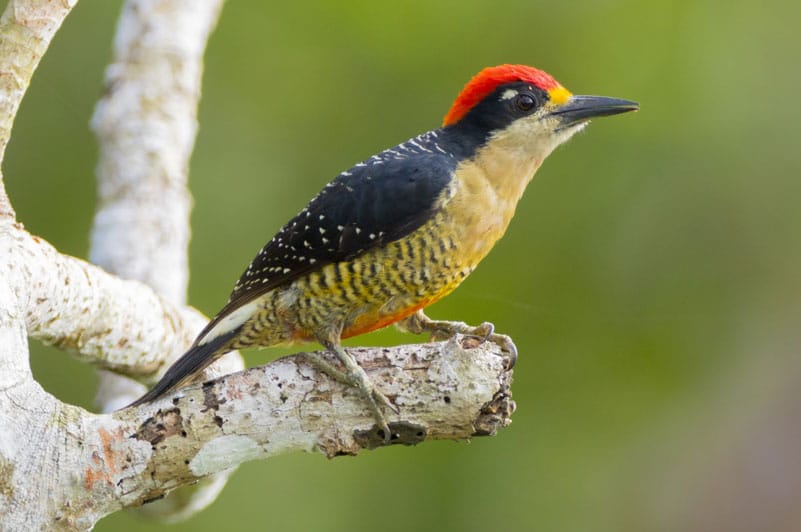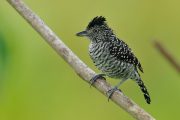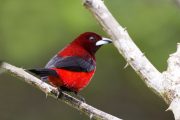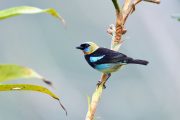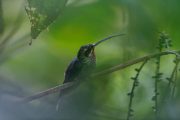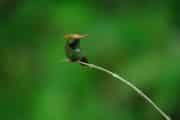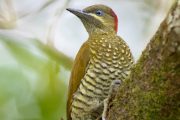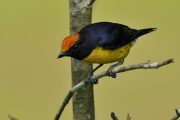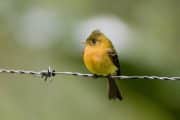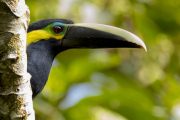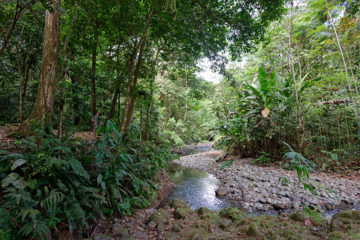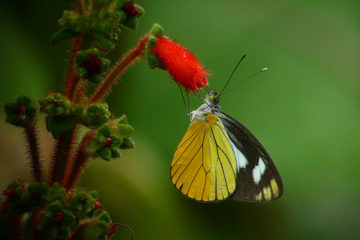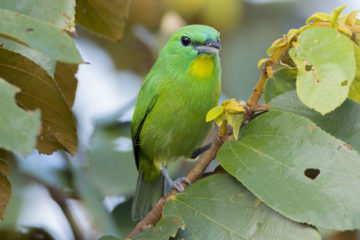Our signature, comprehensive 14-night tour fully explores the best birding spots of Central Panama, with excursions to the lowland tropical forests of the Canal Zone, including Pipeline Road, Panama Rainforest Discovery Center and Metropolitan Park, to the foothill forests of Cerro Azul/Cerro Jefe, the cloud forests of El Valle de Anton & Altos del Maria, Cerro Gaital Natural Monument and the scrub & rice fields of El Chiru and Juan Hombron. This is a dream itinerary for any serious birder. We’ll enjoy 7 nights lodging at the world-famous Canopy Tower and 7 nights at the charming Canopy Lodge.
14 Night Package (2025): High Season: $5,828 — Green Season: $3,675
14 Night Package (2026): High Season: $6,003 — Green Season: $3,786
Rates in US$ per person (+ taxes), double occupancy
Day 1
PM: Arrival, Orientation & Canopy Tower Observation Deck
Upon arrival at the airport, you will be met by our driver who will transfer you to the Canopy Tower, located at the top of Semaphore Hill in the rainforest of Soberanía National Park. A member of our staff will greet you as you arrive at the Tower, and you will be provided with an orientation on the use of the facilities. At this time we will answer any questions you may have about our guided bird watching tours. As your luggage is being ferried to your room, you may visit the dining/bar area and enjoy a refreshing drink. We highly recommend that you spend some time on the Observation Deck. The view from the platform is incredible! Here, you get a unique eye-level perspective of the rainforest canopy. Many birds, including toucans, parrots, tanagers, hawks, and dozens of others, as well as monkeys, two species of sloth, and other mammals are commonly seen. From this vantage point you can also see ships transiting the Panama Canal, the majestic Centennial Bridge, and miles of rainforest! You may also want to watch the hummingbird feeders at the base of the Tower for Long-billed Hermit, White-necked Jacobin, Violet-bellied & Blue-chested Hummingbirds and White-vented Plumeleteer. Occasionally, a Snowy-bellied Hummingbird is spotted! Dinner at CANOPY TOWER.
Day 2
AM: Canopy Tower & Semaphore Hill Road
Your guide will be waiting for you at the Observation Deck for early morning guided bird watching. While you look for birds you can enjoy hot coffee, tea and orange juice. Some of the bird species that we may see from the observation deck are Green & Red-legged Honeycreepers, Green Shrike-Vireo, Blue Cotinga, Scaled Pigeon, Mealy & Red-lored Parrots, Keel-billed Toucan, Collared Araçari, Red-capped & Blue-crowned Manakins, a huge diversity of flycatchers and tanagers, and raptors including King Vulture and Black Hawk-Eagle! After breakfast, at mid-morning, you’ll begin your bird tour by exploring Soberanía National Park by taking a pleasant walk down Semaphore Hill Road. This winding, shady paved road, festooned on the shoulders by wildflowers of many types, is a little more than a mile long and crosses a large creek about half-way down. The bird list here is extensive, and includes birds from the forest interior as well as edge-dwellers. Olivaceous Flatbill, Plain Xenops, Lesser Greenlet, Black-breasted & White-whiskered Puffbirds, Fasciated & Black-crowned (formerly Western Slaty) Antshrikes, Slate-colored Grosbeak, Bay-headed & White-shouldered Tanagers, Black-throated Trogon, Broad-billed & Rufous Motmots, and even Great Jacamar may be found. Great Tinamou is often heard, but is harder to find. This road is also great for raptors, including White, Tiny & Great Black Hawks. During migration it’s easy to see more than 10 species of warbler in one morning. Your morning bird list will be impressive, as we get a much-welcomed ride back from this morning’s bird tour, just in time to enjoy a delicious lunch at the CANOPY TOWER.
PM: Ammo Dump Ponds & Environs (15 min. from Canopy Tower)
The Ammo Dump Ponds are located just past Gamboa on the way to the Pipeline Road. It is the best place to see the elusive White-throated Crake, as well as a host of other waterbirds. Rufescent Tiger-Heron, Wattled Jacana, and Purple Gallinule are common, and Least Grebe and American Pygmy-Kingfisher are also resident. In this area we often find Greater Ani, Red-legged Honeycreeper, Whooping Motmot (recent split from Blue-crowned), Yellow-tailed Oriole, Southern Lapwing, Anhinga, Yellow-crowned Tyrannulet, Scrub Greenlet, Lesser Kiskadee, Black-bellied Whistling-Duck, Panama, Social & Rusty-margined Flycatchers, and even Olivaceous Piculet! Dinner at CANOPY TOWER.
Day 3
World Famous Pipeline Road (20 min. from Canopy Tower) FULL DAY BIRD TOUR
After breakfast you will continue your guided bird watching tour by boarding the Birdmobile or El Tinamu, both open-air vehicles, to take you to the Pipeline Road, the best place in Central Panama to find forest birds and one of the premier birding spots in the world! Eight species of wren, 5 trogons, 4 puffbirds, 3 motmots, several tanagers, Great Jacamar, Common Potoo, Pheasant Cuckoo, Great Tinamou and many other species have been recorded here, even including the elusive Rufous-vented Ground-Cuckoo and the majestic Harpy Eagle! And if its 17 km are not enough, there’s plenty of side trails, plus 11 creeks and rivers that can be followed into the forest. We will also search for Streak-chested Antpitta and Black-faced Antthrush. Army ant swarms are found frequently, attended by a host of birds including Bicolored, Ocellated & Spotted Antbirds. Plus, we will look for Golden-collared, Red-capped & Blue-crowned Manakins, always guest favorites. Pipeline Road is also a great place for raptors. Three forest-falcons are resident as well as Tiny & Semiplumbeous Hawks and Ornate & Black Hawk-Eagles. Also present are Purple-throated Fruitcrow, Black-crowned & Masked Tityras, Cinnamon & Crimson-crested Woodpeckers, Scarlet-rumped Cacique, Red-lored & Brown-hooded Parrots, Collard Araçari, Keel-billed & Yellow-throated Toucans, and Black-striped, Northern Barred & Plain-brown Woodcreepers, to name a few! After this morning’s guided bird watching tour, we will enjoy a picnic lunch in the forest. Dinner at CANOPY TOWER.
Day 4
AM: Pipeline Road Entrance (20 min. from Canopy Tower)
On today’s bird tour, we head back to the Pipeline Road! Today we will concentrate our efforts at the beginning of Pipeline, another diverse area full of birds. Greater Ani, Gray-cowled Wood-Rail, Yellow-tailed Oriole, Masked Tityra, Rosy Thrush-Tanager, Isthmian (formerly Plain) Wren, Streaked Flycatcher, Red-throated Ant-Tanager, Squirrel Cuckoo, Gray-headed Chachalaca, Southern Bentbill, Forest Elaenia, Panama Flycatcher, Blue Ground Dove, and Little Tinamou may be seen here. Other birds recorded are Black-bellied & Buff-breasted Wrens, Golden-collared Manakin, White-necked Puffbird, Gartered, Slaty-tailed, Black-throated, White-tailed & Black-tailed Trogons, Purple-crowned Fairy, Yellow Tyrannulet, White-bellied & Dusky Antbirds, and Fasciated & Black-crowned Antshrikes. During migration this entrance road is excellent for migrant warblers, flycatchers, grosbeaks, and tanagers. Lunch at CANOPY TOWER.
PM: Panama Rainforest Discovery Center (30 min. from Canopy Tower)
After lunch and a rest, we continue our guided bird watching tour at the Panama Rainforest Discovery Center, an ecotourism and environmental education facility created and administered by Fundacion Avifauna Eugene Eisenmann. It is located off Pipeline Road adjacent to Soberanía National Park. The center contains several attractions, the best of which is a 100-foot-tall observation tower, with 4 rest platforms—each stopping at a different layer of the rainforest. The view from the top is incredible! Here, we scan for raptors like Double-toothed Kite and Semiplumbeous Hawk and canopy birds like Scaled Pigeon, Pied Puffbird, and Blue Cotinga. We will also take a quick bird tour through the 1.1 kilometer circuit of well-maintained forest trails, one ending at a pond, which is excellent for birds! Snail Kite, Wattled Jacana, Little Blue Heron, Least Bittern, and Sungrebe are often resident at the pond, and along the trails we look for White-necked & White-whiskered Puffbirds, motmots, trogons, manakins, antbirds, wrens, tanagers, flycatchers, and many others. The covered Visitor Center has several hummingbird feeders (attracting many species that may be photographed easily), bathrooms, lunch tables and a small gift shop with drinks and snacks. Dinner at CANOPY TOWER.
Day 5
AM: Metropolitan Natural Park (25 min. from Canopy Tower)
We will go to Metropolitan Natural Park for this morning’s bird tour. “Metro Park,” encompassing 265 hectares, has the distinction of being the only large forested park within a metropolitan capital in Latin America. More importantly, it protects 192 hectares of dry lowland Pacific forest, yielding bird species that are difficult to find elsewhere. The beautiful Rosy Thrush-Tanager is here, as is the striking Lance-tailed Manakin. This is also a good place to find Southern Bentbill, Rufous-and-white, Isthmian & Rufous-breasted Wrens, Dusky Antbird, Crimson-crested, Lineated & Red-crowned Woodpeckers. Plain-colored, Palm, Blue-gray & Golden-hooded Tanagers are common. Red-legged & Green Honeycreepers, Whooping Motmot (recent split from Blue-crowned), Keel-billed Toucan, Collared Araçari, and the endemic Yellow-green Tyrannulet are resident along with Forest & Greenish Elaenias. In October & November, the overlook along Mono Titi trail is a good spot to witness the mass migration of thousands of Turkey Vultures and Swainson’s & Broad-winged Hawks as they fly over Panamá City toward their wintering grounds in South America. Lunch at CANOPY TOWER.
PM: Summit Ponds & Old Gamboa Road (10 minutes from Canopy Tower)
Old Gamboa Road and the associated ponds at Summit are great places to find Canal Zone birds. On this afternoon’s guided bird watching tour at Summit Ponds, we will scan for Green, Striated, Capped & Boat-billed Herons as well as Green, Ringed, Amazon, Green-and-rufous (rare) & American Pygmy Kingfishers, which are all resident here! Also we seek out Rusty-margined & Streaked Flycatchers, Lesser & Great Kiskadees, Greater Ani, Mangrove Swallow, Bat Falcon, Cocoa Woodcreeper, and Lineated Woodpecker. Going straight past the two ponds you’ll be on Old Gamboa Road, one of the birdiest spots around. This road passes through a variety of habitats and has plenty of specialties, including Blue Ground Dove, Great Antshrike, Jet Antbird, Black-tailed, Bran-colored & Royal Flycatchers, Lance-tailed & Golden-collared Manakins, and the delightful Rosy Thrush-Tanager! We also will find species like White-bellied Antbird, Yellow-bellied Elaenia, Yellow-backed Oriole, Boat-billed & Fork-tailed Flycatchers, Yellow-headed Caracara, Crane Hawk, Black-chested Jays and more. Also resident are Gray-headed Chachalaca, with Spectacled Owl a real possibility too, as the guides know where they often roost. Dinner at CANOPY TOWER.
Day 6
Cerro Azul & Cerro Jefe (1 hr. from Canopy Tower) FULL DAY
After breakfast we continue our bird tour on the hills above Tocumen where a completely different climate and, more importantly, a different suite of birds awaits! The weather will be much cooler and breezier as we ascend the foothills of the San Blas Mountains toward Cerro Azul (2,500 ft.) and Cerro Jefe (3,300 ft.), named after the two tall peaks in the area. Major targets in these cloud-forested hills with peaks of elfin forest will include Yellow-eared Toucanet, Black-and-white Hawk-Eagle, Ornate Hawk-Eagle, Spot-crowned Barbet, Black-eared Wood-Quail, and a nice mix of tanagers, including Silver-throated, Emerald, Speckled, Rufous-winged, Bay-headed, Black-and-yellow, Golden-hooded and Hepatic. We can also search for the specialty hummers, including Rufous-crested Coquette, White-tipped Sicklebill, Bronze-tailed Plumeleteer, Green Thorntail, as well as Violet-capped, Violet-headed & Snowy-bellied Hummingbirds! We should also find the endemic Stripe-cheeked Woodpecker, along with Lineated Woodpecker, Black-striped & Spotted Woodcreepers, Red-capped & White-ruffed Manakins, Russet Antshrike, White-vented & Tawny-capped Euphonias, and Blue Cotinga. We have lunch at a picturesque residence with active hummingbird and tanager feeders perfect for close-up views and photographs! Later, while enjoying dinner at the CANOPY TOWER, we all will reminisce on all the glorious birds that we saw on today’s guided bird watching tour!
Day 7
AM: Plantation Trail (5 min. from Canopy Tower)
After breakfast, we continue our bird tour at Plantation Trail at the base of Semaphore Hill, one of our premier birding areas, often said to rival the Pipeline Road itself! This easy trail passes through mature rainforest and follows a small creek (Rio Chico Masambi) and is a reliable place to find Golden-crowned Spadebill. Oftentimes at the parking area near the entrance, we find Black-chested Jays. Other birds to look for along the trail include Ocellated, Bicolored, Chestnut-backed, White-bellied & Spotted Antbirds; Broad-billed & Whooping Motmots, five species of trogon; White-whiskered Puffbird; hummingbirds (Blue-chested, White-necked Jacobin and others); Plain-brown, Northern Barred, Cocoa, & Ruddy Woodcreepers; Cinnamon, Crimson-crested & Black-cheeked Woodpeckers; White-breasted Wood-Wren; Song Wren; Dot-winged, Checker-throated & White-flanked Antwrens; Purple-throated Fruitcrow; Bright-rumped Attila; Gray-headed Tanager; Long-billed Gnatwren; Black-crowned & Fasciated Antshrikes; Red-capped & Blue-crowned Manakins; Great Tinamou; Ruddy-tailed, Royal & Yellow-margined flycatchers; Yellow-rumped Cacique; Scaly-throated Leaftosser; and, occasionally, Great Jacamar or the endemic Yellow-green Tyrannulet! Lunch at CANOPY TOWER.
PM: Chagres River/Gamboa Feeders (15 min. from Canopy Tower)
After lunch, we continue our guided bird watching tour by taking a short drive to the Chagres River and the accompanying fields & forest. First, we must stop at the Canopy Bed & Breakfast in the picturesque village of Gamboa, to look at the bird feeders! With a beautiful backdrop of Cerro Pelado, the backyard at the Canopy B&B is teeming with bird life. At the fruit feeders, we are likely to see Red-legged, Shining & Green Honeycreepers, Flame-rumped, Crimson-backed & Blue-gray Tanagers, Thick-billed Euphonia, Yellow-bellied & Variable Seedeaters, Whooping Motmot, and Gray-headed Chachalaca. Next, we’re off to Chagres River, the main tributary for the Panama Canal. The birding along the river banks and the forest edges of Gamboa Resort can be spectacular. Here, we search for Amazon, Green & American Pygmy Kingfishers, as well as Whooping Motmot and Cinnamon Woodpecker. We could also see Gray-cowled Wood-Rail, Cocoi, Green & Striated Herons, Wattled Jacana, Pied-billed Grebe, Anhinga, Royal & Sandwich Terns, Brown Pelican, Neotropic Cormorant, Tricolored & Little Blue Herons, Rufescent Tiger-Heron, Mangrove Swallow, Black-chested Jay, Lesser Kiskadee, Rusty-margined Flycatcher, Yellow-billed Cacique, Black-bellied & Buff-breasted Wrens, Fasciated & Barred Antshrikes, Cinnamon Becard, Slaty-tailed Trogon, White-bellied Antbird, and even Slaty-backed Forest-Falcon and Blue Cotinga at times! Dinner at CANOPY TOWER.
Day 8
Canopy Tower/Departure to Canopy Lodge
Canopy Lodge Grounds & Feeders
No need to wake up early for today’s birding trip. After a leisurely breakfast and a last look at the birds from the Observation Deck, we’ll board a comfortable air-conditioned van for the 2-hour ride to El Valle de Antón, also known as Crater Valley. We will spend seven nights at this lovely village, nestled in the caldera of a long dormant volcano that last erupted 5 million years ago. The resulting scenery is quite unique: a steep valley surrounded by jagged peaks and filled with flowers, streams, and verdant forests. We arrive in time for lunch. Our home for the next seven nights will be the Canopy Lodge, sister lodge of the Canopy Tower, a charming eco-lodge built next to a bubbling mountain stream and adjacent to the protected area of Cerro Gaital Natural Monument. At 2,400-feet in elevation, you will immediately appreciate the noticeably cooler temperatures here! A member of our staff will greet you as you arrive at the Lodge, and you will be provided with an orientation on the use of the facilities. At this time we will answer any questions you may have. As your luggage is being ferried to your room, or after you get settled in, you may visit the dining area and enjoy a refreshing drink and snack. You will immediately want to scan the bird feeders and grounds! You may see a variety of birds including Crimson-backed, Blue-gray, White-lined, Flame-rumped, Dusky-faced & Plain-colored Tanagers, Red-crowned Ant-Tanager, Thick-billed Euphonia, Chestnut-headed Oropendola, Streaked & Buff-throated Saltators, Lineated & Red-crowned Woodpeckers, Red-legged Honeycreeper, Yellow-faced Grassquit, Social Flycatcher, Ruddy Ground Dove, Barred Antshrike, Clay-colored Thrush, Rufous Motmot, Rufous-tailed, Snowy-bellied & Violet-headed Hummingbirds, and Garden Emerald! Lunch and Dinner at CANOPY LODGE.
Day 9
AM: La Mesa Road (15 min. from Canopy Lodge)
After breakfast, we continue our birding trip with a trip to La Mesa Road. This area, which is a visually pleasing blend of secondary forest, scrubby pastures, overgrown fincas and grassy borders, is home to many of the area’s specialties. Here is where we look for such great Panamanian birds as Spot-crowned Barbet, Cinnamon Becard, Scarlet-thighed Dacnis, Silver-throated, Golden-hooded, Tawny-crested & Bay-headed Tanagers, Spot-crowned Antvireo, Spotted Woodcreeper, and hummers such as White-tipped Sicklebill, Rufous-crested Coquette, Crowned Woodnymph, and Black-throated Mango. Also resident are Northern Emerald-Toucanet, Bran-colored Flycatcher, Scale-crested Pygmy-Tyrant, and Orange-bellied (Collared) Trogon. Lunch at CANOPY LODGE.
PM: Cariguana (15 min. from Canopy Lodge)
With a full stomach and some rest, we continue our birding trip at the Cara Iguana Trail, where we enjoy outstanding foothill birding in some of the last remaining stands of quality Pacific dry forest. Specialties we hope to find in this bird-rich habitat are Lesser Elaenia, Yellow-olive & Panama Flycatchers, Pale-eyed Pygmy-Tyrant, Yellow-bellied Elaenia, Lance-tailed Manakin, Rufous-breasted & Rufous-and-white Wrens, Rosy Thrush-Tanager, Tody & Lesson’s Motmots, and Long-billed Gnatwren. We may also see such birds as the Striped Cuckoo, Little Tinamou, Common Potoo, Dusky & White-bellied Antbirds, Barred Antshrike, White-winged Becard, Tropical Screech-Owl, and Bat Falcon. Hummers to watch for are Garden Emerald, Long-billed Starthroat, and White-vented Plumeleteer. During migration we look for Bay-breasted, Chestnut-sided, Black-throated Green & Worm-eating Warblers. Dinner at CANOPY LODGE.
Day 10
Pacific Dry Forest & Santa Clara Beach (45 min. from Canopy Lodge) FULL DAY
After breakfast we are off for a full-day birding trip in the Pacific dry forest with its unique cast of Panamanian birds! Among the birds we will be seeking out today are Yellow-headed Caracara, Roadside, Gray-lined, Zone-tailed, Savanna & Short-tailed hawks, Peregrine & Aplomado (rare) Falcons, White-tailed Kite, and Ferruginous Pygmy-Owl. We will also search for Crested Bobwhite, Pale-eyed Pygmy-Tyrant, Golden-fronted Greenlet, Grassland Yellow-Finch, Rufous-browed Peppershrike, Brown-throated Parakeet, Blue Ground Dove, Red-breasted Meadowlark, Fork-tailed Flycatcher, and Crested Oropendola. We stop at a spot where we sometimes find Common Potoo. Hummers to be on the watch for in this unique scrubby area are the near-endemic Veraguan Mango and Garden Emerald. We take a pause in our birding trip to enjoy a picnic lunch at a popular beach at Santa Clara where we hope to spot Sapphire-throated Hummingbird working the coastal shrubbery. You may want to bring your bathing suits to take a dip in the warm waters of the Pacific Ocean (80F/27C).On the beach or flying by may be Least, Western & Spotted Sandpipers, Sanderling, Blue-footed & Brown Boobies, Sandwich, Royal & Elegant Terns, Willet, Whimbrel, and Franklin’s & Laughing Gulls. At the Juan Hombron rice fields we hope to find Lesser Yellow-headed Vulture, Crested Caracara, Gray-cowled Wood-Rail, Northern Scrub-Flycatcher, Southern Lapwing, Great Blue Heron, Tricolored Heron, Black-crowned Night-Heron, Glossy Ibis, Straight-billed Woodcreeper, Pale-breasted Spinetail, Plain-breasted Ground Dove, Mouse-colored Tyrannulet, Common (or Mangrove) Black Hawk, and Pearl Kite. Dinner at CANOPY LODGE.
Day 11
Altos del Maria (1 hr. from Canopy Lodge) FULL DAY
Departing early in the morning after breakfast, we drive from El Valle in air-conditioned 4×4 SUVs up into the mountains for today’s birding trip. As the sun rises over the highlands ahead of us, spectacular mountains, vast valleys and towering cliffs come into view! Set in the mountains on the continental divide east of El Valle, Altos del Maria provides a spectacular addition to the Birds of Central Panama tour. Ascending an excellent paved road, we will climb a ridge to our destination, an expansive area of cloud forest at 3,600 ft. This area harbors an exciting variety of highland forest birds. Some of the characteristic species of this cloud forest include Yellow-eared Toucanet, Black Guan, Black-crowned Antpitta, Black-headed Saltator, White Hawk, Barred Forest-Falcon, Orange-bellied (Collared) Trogon, Spotted Woodcreeper, Red-faced Spinetail, Spotted Barbtail, Russet & Great Antshrikes, Tufted & Sulphur-rumped Flycatchers, Rufous-browed Tyrannulet, White-ruffed Manakin, Ochraceous Wren, Gray-breasted Wood-Wren, Pale-vented Thrush, Green Shrike-Vireo, Yellow-billed Cacique, Slate-colored Grosbeak, and Black-and-yellow, Bay-headed, Dusky-faced & Tawny-crested Tanagers. Even the bizarre Brown-billed Scythebill is seen here regularly. Hummers we may spot include Band-tailed Barbthroat, the exquisite Snowcap, Garden & White-tailed Emeralds, Purple-throated Mountain-Gem, White-tipped Sicklebill, and Bronze-tailed Plumeleteer. After a picnic lunch in the field, we will drop down into a valley and climb to the ridge on the opposite side. Reaching some large swaths of mature humid forest along this ridge, we will explore some trails and roadside spots in search of even more forest birds. Around mid-afternoon, we will head back into El Valle for some relaxation time prior to dinner at the CANOPY LODGE.
Day 12
AM: Cerro Gaital (20 min. from Canopy Lodge)
Today after breakfast, we proceed to Cerro Gaital, a steep, forested, mist-shrouded mountain that you can see from the Lodge! Cerro Gaital (3,500’) is the namesake of Cerro Gaital Natural Monument, which protects more than 335 hectares of mature cloud forest. This area offers sightings of Black Guan, Northern Emerald-Toucanet, Orange-bellied (Collared) Trogon, Spotted Barbtail, Common Chlorospingus, Silver-throated Tanager, Black-headed Antthrush, Slaty Antwren, Spot-crowned & Plain Antvireos, Black-faced Grosbeak, Blue Seedeater, Rufous-capped Warbler, Gray-headed Kite, White Hawk, Tawny-capped Euphonia, Pale-vented Thrush, Northern Schiffornis, White-tailed Emerald, Green-crowned Brilliant, Violet-headed Hummingbird, and Crowned Woodnymph. Scaled Antpitta and Rufous-vented Ground-Cuckoo have been recorded here! Back for lunch at the CANOPY LODGE.
PM: Las Minas Trail (20 min. from Canopy Lodge)
After lunch, we head to Las Minas, an excellent trail for Panamanian bird watching. The road follows the ridge line, with sweeping vistas of forested mountains, speckled with grasslands and small fincas. The views from here are fantastic, as on a clear day near the summit, both the Atlantic and Pacific Oceans can be seen! Specialties of the region include Wedge-tailed Grass-Finch, Black-and-yellow, Bay-headed & Emerald Tanagers, Tawny-capped Euphonia, Scale-crested Pygmy-Tyrant, Spot-crowned Antvireo, Gray-headed Kite, Barred Hawk, Bat Falcon, Ornate Hawk-Eagle, Swallow-tailed Kite, Bronze-tailed Plumeleteer, White-tipped Sicklebill, Green Thorntail, Orange-bellied (Collared) & Black-throated Trogons, Tawny-faced Gnatwren, Plain Antvireo, the endemic Stripe-cheeked Woodpecker, Spotted Woodcreeper, Red-capped & White-ruffed Manakins, Band-rumped Swift, and Black Guan. A forested slope here is also our best chance for Black-crowned Antpitta and Black-headed Antthrush! We get back in time to enjoy appetizers before dinner at the CANOPY LODGE.
Day 13
Rio Indio & Jordanal (40 min. from Canopy Lodge) FULL DAY
After breakfast we depart for a fun-filled day of Caribbean slope birding! These fine, forested areas are not well-birded—by anybody—so who knows what might turn up! First stop is at Rio Indio, a great spot to try for the area’s specialties—Sulphur-rumped Tanager, Spot-crowned Barbet, and Barred Puffbird! We also strive to find Crested Oropendola, White-vented Euphonia, Buff-rumped Warbler, Long-tailed Tyrant, and raptors such as White & Gray-lined Hawks and Black Hawk-Eagle, as well as White-collared & Band-rumped Swifts. Hummers to look for are Green, Long-billed & Rufous-breasted Hermits, and White-necked Jacobin. We search for Lineated & Red-crowned Woodpeckers, Jet & Dusky Antbirds, Lesser & Yellow-bellied Elaenias, Tropical Pewee; Dusky, Piratic & Gray-capped Flycatchers, Cinnamon & White-winged Becards, Black-chested Jay, Bay Wren, Tawny-capped Euphonia, and Emerald, Bay-headed & Golden-hooded Tanagers! If that is not enough, we hope to see Shining Honeycreeper, Yellow-bellied Seedeater, Thick-billed Seed-Finch, Black-striped Sparrow, and Streaked & Buff-throated Saltators. After a pleasant picnic lunch at a thatched-roof shelter on the Jordanal River, we bird our way back to the Canopy Lodge where a relaxing afternoon awaits us—but not until we check the feeders one last time! Dinner at CANOPY LODGE.
Day 14
AM: Watercress Trail (15 min. from Canopy Lodge)
After breakfast we are off to the Watercress Trail, named after the herb (Rorippa nasturtium-aquaticum) which is commercially grown in the terraced creek near the entrance. This easy trail traverses through good secondary forest, which is framed by the picturesque forested mountains of Cerro Gaital Natural Monument. Good birds here are Rosy Thrush-Tanager, Black-headed Saltator, Great Antshrike, White-ruffed Manakin, White-thighed Swallow, White-bellied Antbird, Tody Motmot, and hummers such as Long-billed Starthroat, Rufous-crested Coquette and, when the Inga is in bloom, Snowcap! We will also listen for Purplish-backed Quail-Dove. Lunch at CANOPY LODGE.
PM: Valle Chiquito (20 min. from Canopy Lodge)
After lunch we are off to Valle Chiquito! This valley is accessible by a newly paved road and passes through nicely forested woodlands crossed by two rivers. At Rio de Jesus we search for Green Kingfisher and listen for Sepia-capped Flycatcher. We also admire a colony of Chestnut-headed Oropendolas in a Cecropia tree. We try for Tody Motmot, Yellow-throated Vireo, Yellow-backed Oriole, White-bellied Antbird, Gray-chested Dove, Yellow-billed Cacique, Zone-tailed & Gray-lined Hawks, Black Hawk-Eagle, Lance-tailed Manakin, Panama Flycatcher, Black-headed Tody-Flycatcher, Little Tinamou, Long-billed Starthroat, and Garden Emerald. Wrens are abundant here, with Black-bellied, Rufous-and-white, Bay, and Rufous-breasted Wrens all lurking about in the thickets! Dinner at CANOPY LODGE.
Day 15
Departure to Airport (about 3 hrs. from Canopy Lodge)
After a leisurely breakfast and some last minute birding in the gardens surrounding the lodge, we will drive back to Panamá City and catch our return flights home.
Please note that the itinerary is flexible, and may change without prior notice due to weather, alterations in habitat or other conditions.
Canopy Tower
The Canopy Tower is located in impressive rainforest atop Semaphore Hill within Soberanía National Park, 35 miles north of Panamá City in the Republic of Panamá right in the center of the New World— and just 2½ hours from Miami! It’s one of best locations for birding lodges in Panama.
Canopy Lodge
El Valle de Antón In Coclé Province, home to both the Canopy Lodge and the Canopy Adventure, is an enchanting mountain valley town much cooler than the tropical lowlands. Surrounded by scenic misty mountains traversed by creeks, its true charm is revealed by its unhurried pace and its peaceful residents. Located just two hours from Panama City, El Valle is the perfect resting place for someone trying to escape traffic jams, office buildings, pollution and the pressures of everyday city life.

